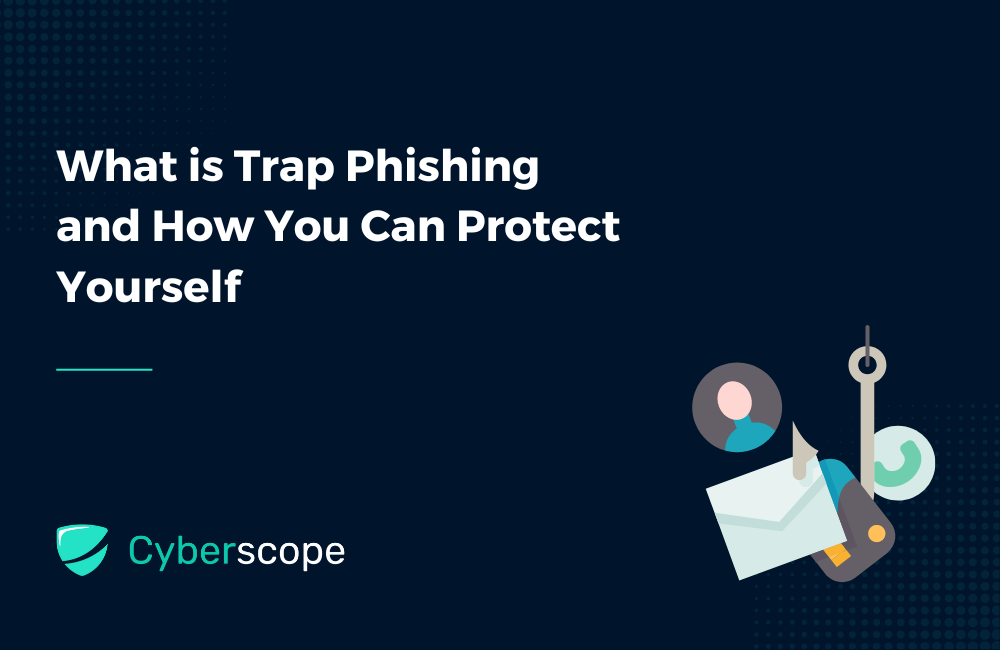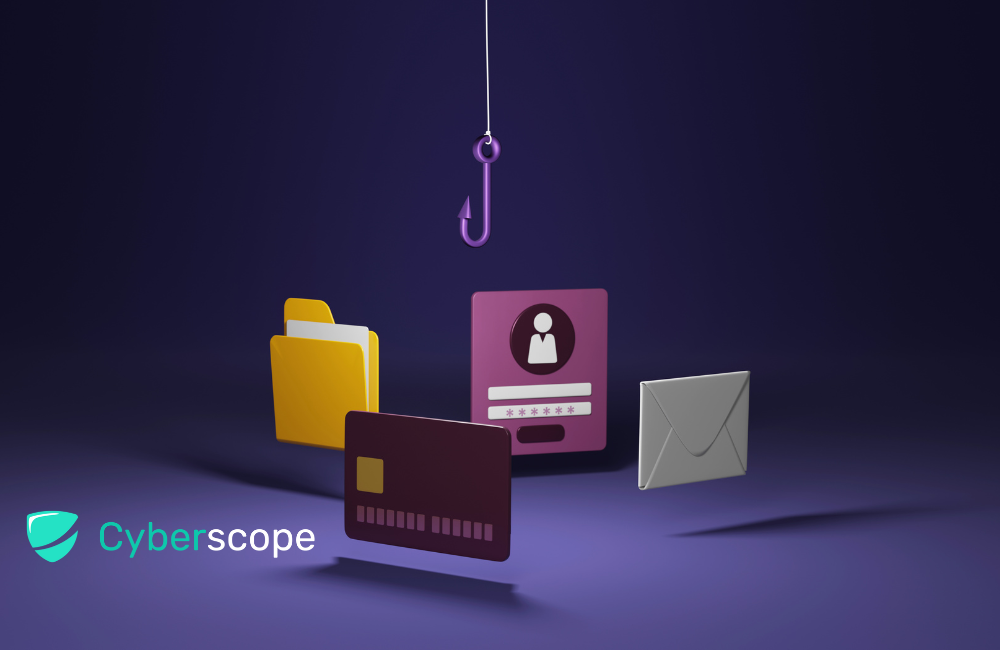

What is Trap Phishing and How You Can Protect Yourself

Imagine opening your inbox or scrolling through social media and finding a message that seems too intriguing to ignore. This message could promise amazing deals, urgent alerts, or even pretend to be from someone you trust.
But here’s the twist - it’s a trap. This is “Trap Phishing,” the most common trick in the cybercrime book.
In 2022, nearly half of all emails sent across the globe were spam. Yes, you read that right - almost 49%. Another report by Verizon's Data Breach points out that a whopping 84% of cyber breaches play on human psychology through social engineering tricks.
In this post, we will unravel the mystery of trap phishing. We'll explore how these attacks unfold, the various disguises they wear, and, most importantly, how you can shield your business from these digital predators.
Understanding Trap Phishing

Imagine a typical day at work. Amid your usual emails, there’s one that catches your eye – it seems to be from your bank, asking you to click a link to verify your account details. This is where the danger of trap phishing lurks, a cunning cyber trick that misuses trust to lead you into a trap.
Here’s how the trap springs:
- Malware in Disguise: A seemingly harmless attachment might start downloading once you click on that link. But it's anything but harmless. This digital trojan horse can unleash chaos, granting attackers access to everything from financial details to personal information. Worse still, it can turn your computer into a puppet, attacking other machines within your network.
- A Fake Sanctuary: Alternatively, that click might whisk you away to a website. It looks and smells like your bank, but it's a facade created by attackers. Here, you’re tricked into handing over your login details on a silver platter.
The aftermath is as you’d expect – a digital nightmare. With your sensitive information in their hands, attackers can impersonate you, drain your bank accounts, or even hold your data hostage.
“Trap phishing is an advanced form of phishing where attackers use detailed information about their targets to craft seemingly legitimate requests or alerts.”
Quick Link: What are Ice Phishing Attacks and How You Can Protect Yourself
Phishing vs. Trap Phishing: Unraveling the Cyber Threats
In the shadowy corners of the internet, cyber attackers lay in wait with two powerful tools in their arsenal: phishing and trap phishing. While both aim to snatch away your most guarded secrets, like passwords or bank details, they both have unique striking methods.
Phishing: The Broad Net
Think of phishing as casting a wide net in the sea, hoping to catch as many fish as possible. Attackers send out generic but convincingly legitimate emails or messages. These could mimic your bank, a popular shopping site, or a social media platform.
The bait? A message urging you to click on a malicious link or log into a fake page designed to look like the real deal. The goal is to lure you into handing over your personal details voluntarily.
Trap Phishing: The Precision Strike
Trap phishing, conversely, is akin to spearfishing — targeting a specific fish with a precise aim. This method involves deep diving into the victim’s world, gathering information to craft a highly personalized attack.
If you’re in finance, the email might appear to come from a top executive in your company asking for urgent financial data. These emails can be so detailed and well-crafted that they seem undeniably authentic, making trap phishing (also known as spear phishing) a formidable threat.
Key Differences
- Scope: Phishing tries to fool anyone and everyone, casting a wide net. Trap phishing zeroes in on specific individuals or organizations, using personalized information for a more convincing lure.
- Customization: Generic messages for phishing; highly customized messages for trap phishing.
- Target: Phishing attacks are random, not caring who bites. Trap phishing is all about hitting a specific target, often with a high value or access to sensitive information.
Understanding these differences is crucial in fortifying your defenses against these cyber threats. You can protect yourself from these digital traps by recognizing the signs and staying vigilant.
Real-Life Examples of Trap Phishing
The CEO Scam
A company's finance officer receives an email seemingly from the CEO, asking for an urgent transfer of funds to a specified account for a confidential deal. The email looks legitimate, complete with the CEO's signature and company logo, leading to a significant financial loss before the scam is uncovered.
The Tax Authority Alert
Individuals receive emails claiming to be from the tax authority, stating that their tax return has a discrepancy that requires immediate attention. A link in the email redirects to a fake website, where personal and financial information is harvested.
The Job Offer Scam
Job seekers often receive emails offering them a position at a renowned company. To secure the job, they are asked to click on a link and enter personal details, which can lead to identity theft.
How Trap Phishing Works

Understanding the inner workings of this scheme is your first line of defense. Here’s how they reel you in:
1. Crafting the Perfect Lure
The first step in a trap phishing operation is for the attacker to study their prey meticulously. They're looking for what makes you tick — the promise of a dream job, the allure of gift cards, or the panic induced by a supposed security breach. This bait is designed to be irresistible, tailored just for you or your role within your organization.
2. Setting the Trap
With the perfect lure, the next move is to lay the trap. This often involves creating a website that's the spitting image of a legitimate one you trust, coupled with an email that mimics a reputable sender.
The goal? To coax you into handing over your login details or personal information. Sometimes, the trap is a malicious attachment or link in the email. Click on it, and you might unwittingly unleash malware on your device.
3. The Heist
Should you take the bait and click on that link or enter your details into the fake site, the cyber thieves have you right where they want you. From there, they can:
- Swipe your credentials to raid your accounts or impersonate you.
- Use your compromised device as a launchpad for attacks on others.
- Sell your data to the highest bidder in the cybercrime underworld.
How to Protect Yourself from Trap Phishing
Let's dive into how you can protect yourself without the clutter of bullet points.
Verify, Don't Just Trust
Question the authenticity of any email or call that requests data. Look at the sender's details closely. Would the real company reach out in this manner, from this specific email, or through this phone number? If something seems off, trust your instincts.
Sense the Urgency Trap
Phishers often create a sense of urgency to provoke a hasty response. Genuine entities usually allow time for proper verification before action is required. If you're pressed for an immediate decision, it's a sign to step back and reassess.
Click With Caution
Avoid clicking on links or downloading attachments from suspicious emails or messages. Instead, navigate to the website directly through a bookmark or a link you know is safe. Always verify the legitimacy of the request through a separate, trusted channel.
Guard Your Personal Data
Be wary of providing sensitive personal information, especially if the request comes out of the blue or doesn't fit the norm of how a company usually communicates with you.
Manage Your Digital Footprint
Limit what you share on social media. Attackers can use the information you post to craft more personalized and convincing attacks. Keep your profile settings private, and be mindful of the details you share.
Fortify Your Accounts
Enable Multi-Factor Authentication (MFA) for an additional layer of security. Even if a phisher gets your password, they won't be able to access your account without this second form of verification. Use strong, unique passwords for each of your accounts to limit the damage of a breach.
Stay Informed
Keep up with the latest phishing techniques. The more you know about how these scams work, the better you can avoid them.
Speak Up
If you encounter a phishing attempt, report it. Whether it's to your workplace's IT department or the company being impersonated, your report can help others avoid falling victim to similar scams.
Keep Your Tech Tidy
Ensure your devices and software are regularly updated. These updates often include patches for security vulnerabilities that attackers could exploit.
When Uncertainty Knocks
If you're unsure whether a communication is legitimate, contact the entity directly via a trusted method. Use a phone number or email address you've obtained from a reliable source, like an official website, not the one provided in the suspicious message.
The Hidden Dangers of Trap Phishing for Businesses
Trap phishing isn't just a minor annoyance; it's a formidable threat that can deeply wound your business. Understanding the breadth of its impact is crucial for prevention and preparedness. Here’s a rundown of how trap phishing can strike at the heart of your operations:
- Financial Hemorrhage: Employees deceived by trap phishing might inadvertently pay fraudsters or leak financial details, leading to unauthorized and often hefty transactions.
- Data Breaches: Your company's lifeblood—sensitive business data, customer records, intellectual property—can fall into the hands of cybercriminals. Once they have it, it's either held hostage, peddled on the dark web, or used as leverage for extortion.
- Reputation on the Line: Trust is hard to build but easy to lose. A single trap phishing incident can erode the confidence customers, partners, and stakeholders place in your business, raising questions about your competence in safeguarding their data.
- Operational Paralysis: Ransomware, a common payload for trap phishing, can lock away essential files and systems, grinding productivity to a halt and inflicting operational and financial pain.
- Customer Exodus: Post-breach, the trust deficit can drive customers away, preferring competitors perceived as more secure. The result? Diminished revenue and a long road to rebuilding trust and loyalty.
- Regulatory Repercussions: Failing to shield customer data tarnishes your reputation and can attract hefty fines and penalties from regulators, adding financial insult to injury.
Other Types of Phishing Attacks
Understanding the various phishing tactics can empower businesses to bolster their defenses and protect their data and resources. Here's a rundown of the primary phishing threats your business should be on alert for:
Email Phishing: The Classic Con
This is the most widespread form of phishing. Attackers craft emails that mimic legitimate correspondence in design and language, often impersonating a familiar contact like a company executive, a trusted business partner, or even a family member. The goal is to entice the recipient to click a malicious link.
Vishing: The Voice Deception
Short for voice phishing, vishing involves fraudsters using phone calls to impersonate someone the victim trusts. Advances in AI and machine learning have enabled criminals to use Deepfake Voice technology, making the impersonation alarmingly convincing. Victims are tricked into sharing personal information or making payments under false pretenses.
Social Media Phishing: The Digital Masquerade
In this scheme, attackers set up counterfeit social media profiles pretending to be reputable business figures or organizations. They use these fake profiles to disseminate links to harmful websites or downloads they control, exploiting the trust placed in the impersonated identities.
Content Injection: The Website Saboteur
Hackers employ this tactic to manipulate legitimate websites by injecting malicious code. This can result in victims being redirected to harmful sites or having their information stealthily harvested. An attack might target a site frequently visited by a company's employees, using it as a trap for unwary visitors.
SMS/Text Phishing: The Mobile Snare
Similar to email phishing but through text messages, this method involves sending fake messages that appear to be from legitimate sources, like banks or reputable companies. The messages contain links that lead victims to enter personal information on fraudulent websites, ultimately leading to financial theft or data breaches.
Summing Up
And there you have it, our journey through the shadowy alleys of trap phishing, a cunning ploy in the vast arsenal of cyber trickery. Like the final twist in a gripping mystery, understanding the depth of deceit in these schemes is critical to securing your digital domain. It's about more than just being cautious; it's about arming yourself with the wisdom to spot these deceptions and the tools to deflect them.
Remember, the cyber world is brimming with these digital wolves in sheep's clothing, but with your newfound knowledge and a sprinkle of skepticism, you're now equipped to see through their disguises. Stay alert, stay informed, and let's turn the tables on these cyber tricksters together. Here's to making your online experience a safer voyage, one click at a time.
Check out Our Blog for more such articles.


